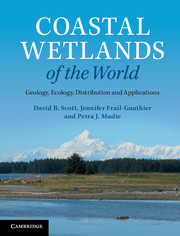Book contents
- Frontmatter
- Contents
- Preface
- List of acronyms and abbreviations
- 1 Introduction: what is covered in this coastal wetlands book?
- 2 Physical aspects: geological, oceanic and climatic conditions
- 3 Zonations and plants: development, stressors and adaptations
- 4 Animals in coastal wetlands: zonation, adaptations and energy flow
- 5 Human intervention causing coastal problems
- 6 Coastal wetlands worldwide: climatic zonation, ecosystems and biogeography
- 7 Examples of North American salt marshes and coastal wetlands
- 8 Examples of South American coastal wetlands
- 9 Africa: selected marsh and mangrove areas
- 10 Europe and Asia: a view of what remains
- 11 Australasia: wetlands of Australia and New Zealand
- 12 Applications in geological monitoring: paleoseismology and paleoclimatology
- 13 Applications in conservation of plant biodiversity and agriculture
- 14 Using mesocosms as a way to study coastal wetlands
- 15 Conclusions and future directions
- References
- Index
- Plate section
12 - Applications in geological monitoring: paleoseismology and paleoclimatology
Published online by Cambridge University Press: 05 July 2014
- Frontmatter
- Contents
- Preface
- List of acronyms and abbreviations
- 1 Introduction: what is covered in this coastal wetlands book?
- 2 Physical aspects: geological, oceanic and climatic conditions
- 3 Zonations and plants: development, stressors and adaptations
- 4 Animals in coastal wetlands: zonation, adaptations and energy flow
- 5 Human intervention causing coastal problems
- 6 Coastal wetlands worldwide: climatic zonation, ecosystems and biogeography
- 7 Examples of North American salt marshes and coastal wetlands
- 8 Examples of South American coastal wetlands
- 9 Africa: selected marsh and mangrove areas
- 10 Europe and Asia: a view of what remains
- 11 Australasia: wetlands of Australia and New Zealand
- 12 Applications in geological monitoring: paleoseismology and paleoclimatology
- 13 Applications in conservation of plant biodiversity and agriculture
- 14 Using mesocosms as a way to study coastal wetlands
- 15 Conclusions and future directions
- References
- Index
- Plate section
Summary
Key points
Coastal ecosystem knowledge is essential for understanding earthquake mechanics and forecasting catastrophic shoreline movement and flooding; multiple sources of fossil proxy-data – including microfossils, pollen and sediment – are best used to reconstruct patterns of earthquakes and tsunamis in time and space; multidisciplinary studies are also needed to distinguish tsunami from tropical storm events; correct measurement of timing and speed of paleoseismic events depend on accurate dating methods, best provided by tree roots and salt marsh peat; foraminifera provide the most precise estimates for amounts of vertical shoreline change; pollen of mangroves and salt marsh plants provide best estimates of climate change; diatom and dinoflagellate paleotransfer functions are best for tracking the prehistoric sea-ice changes.
How wetland archives are used in paleoseismology and paleotempestology
The past is all we know about the future.
(Barbara Kingsolver, The Lacuna, 2009)In Chapters 3 and 4, we explained how study of foraminifera (Box 4.1 Tidal wetland foraminifera) and pollen grains (Figure 3.3) in present-day tidal wetlands can be used to analyse and interpret geological archives of past changes in sea level, salinity and coastal vegetation. Barlow et al. (2013, p. 90) state that, ‘Understanding late Holocene to present relative sea level changes at centennial or subcentennial scales requires geological records that dovetail with the instrumental era. Salt marsh sediments are one of the most reliable geological tide gauges.’ Here we give additional examples of other microfossils and geochemical tracers that can be used as proxies in studies of coastal wetlands, and we describe various case histories for applications in paleoseismology, which is the study of prehistoric earthquakes and tsunamis – particularly their location in space and time. Paleotempestology is the related study of storms and hurricanes from a primarily geological perspective (Liu, 2004, 2007).
- Type
- Chapter
- Information
- Coastal Wetlands of the WorldGeology, Ecology, Distribution and Applications, pp. 248 - 268Publisher: Cambridge University PressPrint publication year: 2014



